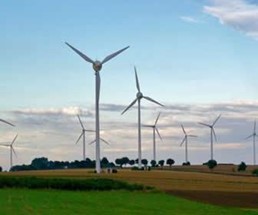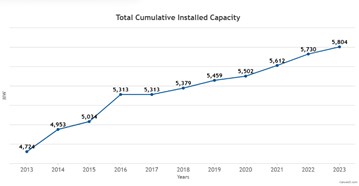- Definition and Types of Energy
- Myths And Misconceptions About Energy
- The Relationship Between Energy and Environment
- Climate Change and Carbon Footprint
- Greenhouse Gas Effect
- The Role of Human-Induced Greenhouse Gases and Energy Consumption
- Energy Efficiency and Sustainability
- Renewable Energy Sources and Future Perspectives
- Play and Learn
- Solar Energy Conversions
- Solar Energy Worldwide
- Solar Energy in Partner Countries
- Positive and Negative Impacts
- Technologies for Harnessing Solar Energy
- Solar thermal energy technologies and applications
- Electricity Generation Methods
- Passive Heating and Cooling of Residences with the Sun
- Concentrator solar power (CSP) systems and electricity generation
- Systems and Applications That Generate Electricity directly from solar rays
- Photovoltaic Cells and Panels
- Domestic PV Systems
- Off-Grid PV Systems
- Hybrid Connected Systems
- Materials Used in PV Cells
- Play and Learn
Wind Energy in Partner Countries
Wind Energy in Türkiye
Although Türkiye is not among the top countries in the world in terms of wind energy capacity, it is one of the leading countries in terms of potential. It is among the top countries in terms of wind energy potential, especially in Europe. Türkiye's wind energy potential has been calculated as 48,000 MW, taking into account regions where winds exceed 7.5 m/s at 50 meters above the ground.
The first studies on wind energy in Türkiye began with academic research. Ankara University in 1960, METU and Ege University in 1970, and TÜBİTAK-MAM in 1980 conducted studies in this field. The Electrical Power Resources Research Administration (EİE) affiliated with the Ministry of Energy and Natural Resources began its work on wind energy in 1981, and a branch office was established in this field in 1989. Within the scope of the Türkiye Wind Atlas Project, observation stations were established in various regions and Türkiye's wind map was drawn
The regions with the highest wind energy potential in Türkiye are as follows:
- Marmara Region
- Aegean Region
- Western Black Sea Region
- Central Anatolia Region
- Southeastern Anatolia Region
- Eastern Anatolia Region

An important step in wind energy in Türkiye was the establishment of the first wind farm in Germiyan village of Çeşme district of İzmir in 1998. This power plant, which contains three turbines with a capacity of 500 kW each, has a total power of 1.5 MW. Many wind power plants have been put into operation since the 2000s. In line with the 2023 targets of the Ministry of Energy and Natural Resources, it is planned to increase the installed power in wind energy to 20,000 MW, solar energy to 5,000 MW and geothermal energy to 1,000 MW. These targets show that wind energy is one of the most developed areas among renewable energy sources in Türkiye. Among the studies carried out to achieve these targets is the Wind Power Monitoring and Forecast Center (RITM) project, jointly carried out by the Ministry of Energy and Natural Resources and the General Directorate of Space and Meteorology of TÜBİTAK. The system developed within the scope of this project is planned to be applied in a wider area.

Wind Energy in Portugal
Wind energy had an exceptional growth in Portugal from 2000 to 2015, reaching an installed capacity of more than 5 GW. From 2015 on, investment in windfarms slowed down. By the end of 2023, the total installed capacity was 5.9 GW, mainly in onshore facilities. It was the second source of electricity production, just below hydroelectric power, with an installed capacity of 8.2 GW. In April 2024, 267 wind farms and 2908 wind turbines were in force.

According to the last version of the National Program for Energy and Climate (PNEC), by 2030, there should be more than 4.1 GW of onshore capacity and 2 GW in offshore structures. The Portuguese Atlantic Coast has a huge potential for offshore structures, leading to plans to install up to 10 GW in the medium term.
As a curiosity, the project WindFloat Atlantic was the world's first semi-submersible floating offshore wind farm, which started operating. It is based on the 2 MW WindFloat1 prototype, which operated successfully between 2011 and 2016 near Póvoa de Varzim (north of Portugal). In 2024, wind energy represented nearly 40 % of all the electricity produced in Portugal.
Wind Energy in Greece
Greece has made significant strides in harnessing wind energy, with its installed wind power capacity reaching 5,226 MW by the end of 2023, up from 1,000 MW in 2010. This growth reflects the country's commitment to expanding renewable energy sources.
The regions with the highest wind energy potential include Central Greece, particularly the prefecture of Evia, which had an installed capacity of 548 MW by the end of 2012, accounting for 31.3% of the nation's total wind power at that time. Additionally, the Aegean islands and parts of Northern Greece have been identified as areas with substantial wind resources.
Looking ahead, Greece aims to further enhance its wind energy capacity, with projections indicating annual onshore wind capacity additions of approximately 400 MW from 2024 to 2030. This planned expansion aligns with the country's broader strategy to increase the share of renewables in its energy mix, contributing to energy security and environmental sustainability.

Moreover, Greece is actively participating in regional collaborations to promote renewable energy. In 2023, a total of 153 wind turbines were newly installed across Greece. This was 85 turbines more than the number installed during the previous year. In September 2024, Greece, along with eight other southern European Union member countries, pledged to transform the Mediterranean region into a renewable energy hub, focusing on offshore wind and solar energy projects. This initiative underscores Greece's dedication to leveraging its geographic advantages for sustainable energy development.
Wind Energy in North Macedonia
North Macedonia, a country striving for a sustainable energy transition, has been actively developing its wind energy sector as part of its broader commitment to reducing reliance on fossil fuels. While historically dependent on coal, the government has set ambitious targets to increase the share of renewables to 50% by 2030 and phase out coal by 2035. Among these efforts, wind energy is emerging as a crucial pillar of the country's renewable energy strategy.

The country’s first and most significant wind power project, Bogdanci Wind Farm, marked the beginning of large-scale wind energy utilization. Located in southeastern North Macedonia, Bogdanci was chosen for its consistent wind speeds, averaging 7 meters per second at a height of 100 meters. The project was initiated by Elektrani na Severna Makedonija (ESM), the state-owned energy company, and supported through financing from the European Bank for Reconstruction and Development (EBRD).
Bogdanci Wind Farm – A Landmark Project
The first phase of Bogdanci Wind Farm became operational in 2014, comprising 16 turbines with a total installed capacity of 36.8 MW. The farm generates approximately 100 GWh of electricity annually, supplying power to over 16,000 households. Recognizing the success of the project, a second phase was planned, aiming to add an additional 14 MW, bringing the total capacity to 50 MW.
The success of Bogdanci demonstrated the feasibility of wind energy in the country and paved the way for further investments and new projects.
Building on this momentum, North Macedonia has launched several new wind power projects that will significantly boost capacity in the coming years. The most important project worth emphasizing is the upcoming Alcazar Energy’s 400 MW Wind Farm – The Largest in the Balkans (Planned, National Level)
Capacity: 400 MW
Investment: Over $500 million
Developer: Alcazar Energy, a major renewable energy company
Expected Start: 2025
Impact: More than doubles the country’s wind power capacity, transforming North Macedonia into a regional leader in wind energy
This massive 400 MW wind project will be the largest wind energy development in the Western Balkans, aligning with North Macedonia’s long-term goal of energy independence and carbon neutrality.
North Macedonia’s diverse topography and geographic positioning create ideal conditions for wind energy in several key regions:
- Southeastern Region – Strong wind currents in Bogdanci, Gevgelija, Valandovo
- Northeastern Region – Promising wind speeds in Kriva Palanka and Kumanovo
- Pelagonia Region – High wind energy potential near Bitola and Prilep
Wind speeds across these areas range between 5.5 and 8.5 m/s, providing optimal conditions for continuous energy generation.